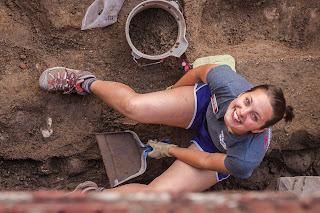The Summer I Lived At A Museum
 |
| Hi! I'm Ana, the Archaeology Intern |
that makes us forget how big the world can really be. (We always joke that if a drive is longer than 15 minutes, we'll have to pack an overnight bag.) Growing up I went to small schools and participated in several clubs, including Academic Decathlon and Environmental club, many sports, including softball, track, and field hockey, and Girl Scouts, remaining a member until I was 18 and progressed through all the ranks to Senior Scout, earning my Gold Award in my final year. After this I went to the University of Rhode Island, where I double majored in History and Anthropology and minored in Underwater Archaeology, completing these degrees in three years. In 2014, I participated in an underwater dig in Akko, Israel, and in 2015 I came to Strawbery Banke as a field student. This year, after a gap year off of school, I am back as the summer-long intern before I start at UMASS Boston for my graduate degree in Historical Archaeology.
For those of you who may not be aware, the internship program provides housing for the out-of-state interns, which means the I, along with four other interns, have spent my summer living at a museum. It's quite a bit different from the children in the book From the Mixed Up Files of Mrs. Basil E. Frankweiler, who run away from home and end up living secretly in New York's Metropolitan Museum of Art. In fact, besides a few rules, living at one of the rehabilitated houses on the museum grounds has been a great experience! Interns live in one side Hough House, which is divided into a duplex, while a few businesses occupy the offices in the other side. Although the outside looks historic, we have all the modern amenities of a current house: running water, electricity, television, WiFi, a fully equipped kitchen, and almost anything else you can think of. The one thing we are not allowed is Air conditioning or window fans, because the museum wants the facade of the house to match the historic neighborhood it represents.
 |
| Hough House |
Having so many people around, however, has also been a bit of a surprise. Besides visitors, we also see the workers in the other half of Hough House and many people who come to tend the community garden behind the house. I have seen people directly outside my windows as early as 5am and at least as as late as midnight.
Because the museum is so busy during the day, we get to interact with a lot more people than we ever would if we were not living on the museum. I have met visitors from all around the USA, not to mention several from foreign countries. We also get to hear more from interpreters and museum role players, who are not only our colleagues during the day, but also serve as stand-in neighbors for the otherwise empty houses. Although you would think that the museum is deserted and quiet after hours, it is almost entirely the opposite. Many locals come to walk their dogs through the open grounds and many events take place on Puddle Dock, including weddings, corporate dinners, fundraisers, and concerts. From our windows, we get to see all of these events from a behind-the-scenes perspective, which is pretty cool. Since we are so close to the downtown area, we also get a lot of firsthand experience with living near Prescott Park, which has events and happenings, like plays and concerts, on most evenings.
After spending my summer here, I can reflect to say that I was most surprised how busy the neighborhood is. Hough House is not on a main road, so most of the traffic we experience is foot traffic and we don't get a lot of noise from cars. What I do see, however, is how much a part of the living community Strawbery Banke Museum has become. From my windows, I see visitors, museum personnel, interpreters, and role players all day, dog walkers, joggers, and families in the afternoons, concert-goers, tourists, restaurant staff and locals in the evenings, and on some special occasions I have seen bands and musicians, performers, wedding parties, corporate groups, vendors, donors, and tour groups. The museum is rarely deserted, and, in fact, seems equally like a part of the past while also playing a truly active role in the present.
Hi Ana,
ReplyDeleteI'm not sure if you'll see this since you're done with your internship, but I figured I'd try. I was looking for a picture of Hough House online and came across your post. I was actually an Anthropology major at URI and lived at Hough House too! I was a Museum Intern & Interpreter at Strawbery Banke in 2006. It was cool to reflect back on that summer via your post.
Sarah